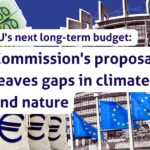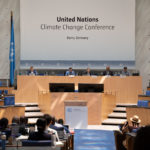BLOG POST
The European Commission released its package of proposals to align climate and energy legislation with its new nationally determined contribution of net 55% emissions reductions by 2030 back in July.
One IPCC report later, and with six weeks to COP26, CAN Europe has taken a look at what the package can do to support a fair approach to international climate action.
Revising the legislation offers an opportunity for the EU to demonstrate a fairer approach to the Paris Agreement, by increasing its ambition in emissions reductions, advancing cooperation and support with climate vulnerable countries, and demonstrating how climate action can foster social goals. As Climate Ministers gather virtually for the UN General Assembly today to discuss climate action, here’s our take on four key areas:
1. Ambition
Dropped during a Summer of dangerous and extreme weather across Europe, the first part of the IPCC’s 6th Assessment report gave us the latest major assessment on the state of science on climate change. The report concludes that temperature is rising faster than expected towards catastrophic rates.
As governments head towards COP26, they should all be taking prompt climate action to align emissions reductions with the 1.5°C target. While the Commission’s proposals foresee a small increase beyond the at least 55% net emission reduction by 2030, overall they leave a substantial gap to what is needed to ensure the EU is contributing its fair share to the global effort to limit temperature rise to 1.5°C. It’s now up to Member States’ and the European Parliament to improve the legislation and enable the EU to overshoot the 55% emission reduction target towards -65% by 2030.
2. Support to climate vulnerable countries
In the Paris Agreement the EU agreed to contribute to a $100 billion annual climate finance goal from developed to developing countries by 2020. But with developed governments off-track, and with finance key to success at COP26 and beyond, the EU should be finding new finance to contribute.
Commission President Ursula Von der Leyen recognised the need for more international climate finance and announced a further €4 billion between 2021 and 2027 in her State of the Union speech last week, making a strong call on the US to stump up more cash. But with the climate crisis coming on top of other development challenges, new sources of finance need to be found on top of the EU budget’s existing funds.
Revenues from carbon pricing and taxation across the ‘Fit for 55’ package could partially be used as new own resources for the EU budget, particularly expected revenues from the new ETS for buildings and transport.
This isn’t good enough in a climate emergency. All revenues from carbon pricing should be channeled to drive ambitious action to transform societies to avoid a worsening emergency. This means support to developing countries, at least half supporting adaptation, as well as for the just transition in Europe.
One positive change relates to ETS revenues under the current system, where Member States currently use 50% of ETS revenues for climate action. According to the Commission proposal, Member States will have to spend all their auctioning revenue on climate-related purposes, and as some do use ETS revenues to fund international climate finance, this is a positive incentive for more. Yet, transparency and scrutiny of Member States’ reporting on revenue use urgently needs to improve.
3. Cooperation to advance international climate action
Aside from climate finance, the EU should take more opportunities in the package to step up its climate cooperation and support, and to counteract negative perceptions of the European Green Deal on the road to COP26. The bilateral climate and energy declarations elaborated in the last months, for example with India, Japan or the USA, plus cooperation with China and the African neighbouring continent in particular, provide a useful framing here as well, but need to be filled with life.
The carbon border adjustment mechanism (CBAM) proposal released by the EC as part of the ‘Fit for 55’ package needs some serious work to ensure it can support the transition in developing as well as neighbouring countries (where if done right, it can support the transition in the Energy Community, see next section). . The CBAM will apply a carbon price equivalent to that faced by EU producers to EU imports in key sectors, like steel, cement and aluminium, to address the risk of “carbon leakage”. But as well as impacting middle and higher income countries, a number of climate vulnerable countries including least developed countries would be affected by the proposal. Any fair approach would see ETS allowances for EU producers in the equivalent sectors swiftly phased out, a structured exemption approach for least developed countries from the carbon border adjustment mechanism, and the revenue should go to international climate finance to support the just transition in other countries.
4. Working with European Neighbours
The European Green Deal underlines the need for close and intense cooperation with the EU’s neighbors in order to ensure the full implementation of the Climate Law’s objective to reach climate neutrality by 2050. The already established mechanisms for cooperation between the EU and some of its neighbouring countries, such as the Instrument for Pre Accession (III), the Energy Community Treaty, as well as the Transport Community Treaty are the right starting points towards engaging with neighbouring countries in efforts to achieve the 2050 goals.
The EU’s ‘Fit for 55 package’ will have a direct impact on these processes, and the EU must ensure that the package supports neighbouring countries to deliver on and enhance their own nationally determined contributions for 2030, and in line with the ongoing drafting of the National and Energy Climate Plans (NECPs).
The EU must further empower the Energy Community Treaty Secretariat to hold to account the Contracting Parties committed to the implementation of the Treaty. The ambition of the Contracting Parties and of the EU should align to achieve the climate neutrality goals, starting from setting the ambitious 2030 energy and climate targets. The accompanying legislative package for the Energy Community must be the underlying harmonization between the EU and the Contracting Parties, especially in governance, renewable energy, as well as the energy efficiency directives.
The IPA III with other supporting financial mechanisms should target development of projects which will further support the efforts of the just transition in the region by 2030, as means to achieve the political pledge of the Western Balkans leaders to reaching carbon neutrality by 2050 (Sofia Declaration on the Green Agenda for the Western Balkans).
Lastly, the Carbon Border Adjustment Mechanism should complement the Energy Community Treaty, incentivizing coal phase out, as well as paving the way for taxing emissions in the neighboring regions, until the region is ready to join the EU ETS.



